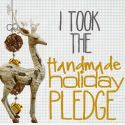I had a request from TropiClay Studio to post a photo of my sculpture (my very first sculpture), Naomi & Ruth, so I thought I'd tell the story. The story of Ruth is contained in the part of the Hebrew Bible called Ketuvim (Writings). It is read on Shavuot, the Festival that commemorates the giving of the Torah at Mt. Sinai.
During the time of the Judges (1244 BCE to 879 BCE) when there was a famine, an Israelite family, Elimelech, his wife Naomi and their sons emigrate to Moab. Elimelech dies, and the sons marry two Moabite women: Mahlon marries Ruth and Chilion marries Orpah.
The two sons of Naomi then die themselves. Naomi decides to return to Bethlehem. She tells her daughters-in-law to return to their own mothers, and remarry. Orpah leaves; however, Ruth says, "Entreat me not to leave you, or to turn back from following you; For wherever you go, I will go; And wherever you lodge, I will lodge; Your people shall be my people, and your God, my God. Where you die, I will die, and there will I be buried.
The two women return to Bethlehem. It is the time of the barley harvest, and in order to support her mother-in-law and herself, Ruth goes to the fields to glean from the corners of a field, as is proscribed for widows. The field she goes to belongs to a man named Boaz, who is kind to her because he has heard of her loyalty to her mother-in-law. Ruth tells her mother-in-law of Boaz's kindness, and she gleans in his field through the remainder of the harvest season. Boaz and Ruth fall in love.
There are legal complications that delay their marriage, but are finally resolved.
Boaz and Ruth get married and have a son named Obed, who because of the previously mentioned legal issues is considered both the son and grandson of Naomi and her husband, as well as the son of Boaz and Ruth. In the genealogy which concludes the story, it is pointed out that Obed is the descendant of Judah, and the grandfather of King David.
My Ruth & Naomi reflects the highlighted portion of the story. Ruth became the first non-Hebrew to convert to Judaism by these words.












.jpg&container=blogger&gadget=a&rewriteMime=image%2F*)



